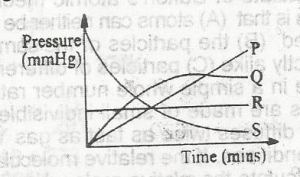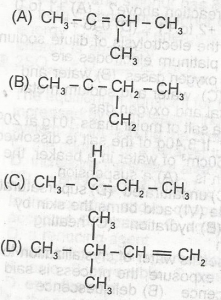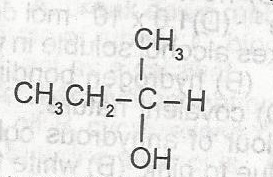Year :
2002
Title :
Chemistry
Exam :
JAMB Exam
Paper 1 | Objectives
41 - 47 of 47 Questions
| # | Question | Ans |
|---|---|---|
| 41. |
The processes which return carbon (IV) oxide to the atmosphere include A. respiration, decay and combustion B. photosynthesis, respiration and transpiration C. ozone depletion, combustion and decay D. photosynthesis, decay and respiration |
A |
| 42. |
The postulate of Dalton's atomic theory which still holds is that A. atoms can neither be created nor destroyed B. the particles of the same element are exactly alike C. particles of different elements combine in simple whole number ratio D. all elemets are made of small indivisible particles Detailed SolutionPostulates of Dalton’s atomic theory can used to explain the behavior of matter:All matter is composed of small tiny particles called atoms. In Greek the word atom is termed as indivisible. The atoms can not be further broken down. All atoms are indivisible, indestructible, and unchangeable. Atom of an element cannot be created, divided, destroyed, or split into smaller particles or transformed into atoms of other elements or transformed into other atoms in a chemical reaction. They are simply rearrangement of new compound. Dalton’s atomic theory based this hypothesis on the law of conservation of mass and on centuries of experimental evidence. |
|
| 43. |
146C → X + B A. 126C B. 125B C. 147N D. 136C Detailed Solution146C → X + B→ X + 0-1e → 147X |
|
| 44. |
If 0.75 mole of cyclopropane and 0.66 mole of oxygen are mixed in vessel with a total pressure of 0.7 atmosphere, what is the partial pressure of oxygen in the mixture A. 0.44 atmosphere B. 0.22 atmosphere C. 0.55 atmosphere D. 0.33 atmosphere |
D |
| 45. |
 In the diagram above, the curve that represents the production of oxgyen gas from the decomposition of KCIO3 in the presence of MnO2 catalyst is A. R B. P C. S D. Q |
B |
| 46. |
 The major product of the dehydration of the compound above is A. A B. B C. C D. D |
A |
| 47. |
 The compound above is A. glycol B. primary alkanol C. secondary alkanol D. tertiary alkanol Detailed SolutionThe compound is BUTAN-2-OL, a secondary alcohol |
| 41. |
The processes which return carbon (IV) oxide to the atmosphere include A. respiration, decay and combustion B. photosynthesis, respiration and transpiration C. ozone depletion, combustion and decay D. photosynthesis, decay and respiration |
A |
| 42. |
The postulate of Dalton's atomic theory which still holds is that A. atoms can neither be created nor destroyed B. the particles of the same element are exactly alike C. particles of different elements combine in simple whole number ratio D. all elemets are made of small indivisible particles Detailed SolutionPostulates of Dalton’s atomic theory can used to explain the behavior of matter:All matter is composed of small tiny particles called atoms. In Greek the word atom is termed as indivisible. The atoms can not be further broken down. All atoms are indivisible, indestructible, and unchangeable. Atom of an element cannot be created, divided, destroyed, or split into smaller particles or transformed into atoms of other elements or transformed into other atoms in a chemical reaction. They are simply rearrangement of new compound. Dalton’s atomic theory based this hypothesis on the law of conservation of mass and on centuries of experimental evidence. |
|
| 43. |
146C → X + B A. 126C B. 125B C. 147N D. 136C Detailed Solution146C → X + B→ X + 0-1e → 147X |
|
| 44. |
If 0.75 mole of cyclopropane and 0.66 mole of oxygen are mixed in vessel with a total pressure of 0.7 atmosphere, what is the partial pressure of oxygen in the mixture A. 0.44 atmosphere B. 0.22 atmosphere C. 0.55 atmosphere D. 0.33 atmosphere |
D |
| 45. |
 In the diagram above, the curve that represents the production of oxgyen gas from the decomposition of KCIO3 in the presence of MnO2 catalyst is A. R B. P C. S D. Q |
B |
| 46. |
 The major product of the dehydration of the compound above is A. A B. B C. C D. D |
A |
| 47. |
 The compound above is A. glycol B. primary alkanol C. secondary alkanol D. tertiary alkanol Detailed SolutionThe compound is BUTAN-2-OL, a secondary alcohol |